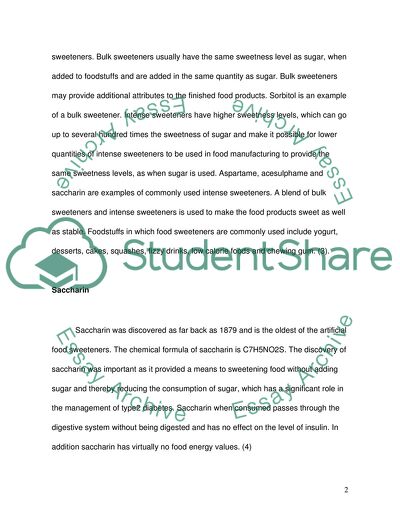
- Home
- Free Samples
- Premium Essays
- Editing Services
- Extra Tools
- Essay Writing Help
- About Us
- Studentshare
- Subjects
- Miscellaneous
- Give an account of the nature of the various types of sweetener that can be used by food manufacturers. Also, illustrate your answer with typical examples of the substances used and their applications
Give an account of the nature of the various types of sweetener that can be used by food manufacturers. Also, illustrate your answer with typical examples of the substances used and their applications - Essay Example
Food sweeteners have gained in significance as attempts to reduce the…

- Subject: Miscellaneous
- Type: Essay
- Level: Undergraduate
- Pages: 4 (1000 words)
- Downloads: 0
- Author: telly11
Extract of sample "Give an account of the nature of the various types of sweetener that can be used by food manufacturers. Also, illustrate your answer with typical examples of the substances used and their applications"
(1). Alternative sweeteners are present in many of the foodstuffs that we consume, but are difficult to identify as they are simply represented by the classification numbers in the ingredients column of the food products. The list of alternative sweeteners is actually fairly large and includes sorbitol, mannitol, acesulphame potassium, aspartame, cyclamate, isomalt, saccharin, sucralose, alitame, thaumatin, neotame and maltitol. (2). Classification of food sweeteners on the basis of their nature and their application in the food industry, finds them classified as bulk sweeteners and intense sweeteners.
Bulk sweeteners usually have the same sweetness level as sugar, when added to foodstuffs and are added in the same quantity as sugar. Bulk sweeteners may provide additional attributes to the finished food products. Sorbitol is an example of a bulk sweetener. Intense sweeteners have higher sweetness levels, which can go up to several hundred times the sweetness of sugar and make it possible for lower quantities of intense sweeteners to be used in food manufacturing to provide the same sweetness levels, as when sugar is used.
Aspartame, acesulphame and saccharin are examples of commonly used intense sweeteners. A blend of bulk sweeteners and intense sweeteners is used to make the food products sweet as well as stable. Foodstuffs in which food sweeteners are commonly used include yogurt, desserts, cakes, squashes, fizzy drinks, low calorie foods and chewing gum. (3). Saccharin was discovered as far back as 1879 and is the oldest of the artificial food sweeteners. The chemical formula of saccharin is C7H5NO2S. The discovery of saccharin was important as it provided a means to sweetening food without adding sugar and thereby reducing the consumption of sugar, which has a significant role in the management of type2 diabetes.
Saccharin when consumed passes through the digestive system without being digested
...Download file to see next pages Read MoreCHECK THESE SAMPLES OF Give an account of the nature of the various types of sweetener that can be used by food manufacturers. Also, illustrate your answer with typical examples of the substances used and their applications
The Advantages and Disadvantages of Food Additive Use
'New' or 'Compositionally Altered' grocery store products
The Use of Sweetners and the Rise in Obesity
Holland Sweeterner Company vs. NutraSweet
Are Food Manufacturers Killing Us
Human Food Toxicant: Popcorn
Why Artificial Sweeteners are Bad for You
How Do Artificial Sweeteners Induce Glucose Intolerance

- TERMS & CONDITIONS
- PRIVACY POLICY
- COOKIES POLICY